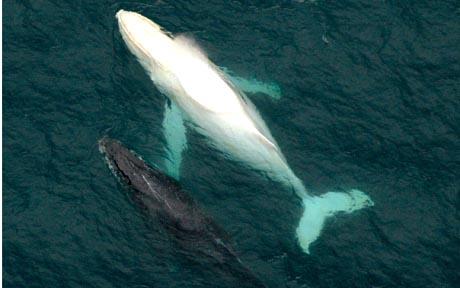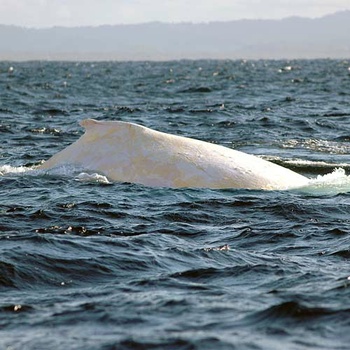Migaloo
Posted by: Loren Coleman on June 30th, 2009

Migaloo, a 45.9 feet (14-meter), 34.4 ton (35-ton) pure white humpback whale, is seen here swimming along the east coast off Australia, near Coffs Harbour with another whale, Tuesday, June 15, 2005. (Sea Experience Charters, Greer Atkinson).
Migaloo is a rare white male humpback whale first spotted in 1991. Experts believe he is now about 21 to 23 years old.
Slipping silently past his biggest fans along the Gold Coast of August — during the dead of night – the big white whale did it again.
On Wednesday morning, July 1, 2009, local time, the rare white whale is expected to be powering past Moreton Island after being spotted off the NSW north coast yesterday, June 30th.
Until now, the albino humpback has been able to keep away from the paparazzi as he migrates north.
“With any luck he’ll be out of media range by the morning,” said Blue Planet Marine’s Dave Paton, who spotted Migaloo about 3km off Evans Head on June 30. “He’s got a good habit of ducking and weaving the media.”
On Tuesday, June 30, 2009, Australian authorities had warned the public to stay away from a rare white humpback whale named Migaloo that has made an appearance off the east coast of that country.
Officials in Queensland state have declared Migaloo a “special-interest whale” and banned anyone from coming within 500 metres of him.
Anyone coming too close by boat, jet ski or aircraft will face a fine of $13,500AU.
Officials said the whale needed to be left alone to migrate up the coast.
“The whale-watching regulations are there to protect the whales, but also to protect people from these huge, unpredictable animals,” said Queensland’s Environment Minister Kate Jones.
“Adult humpbacks can weigh more than a fully-loaded semi-trailer so you need to stay out of their way,” she added.
Migaloo is the only known all-white humpback whale in the world, Professor Peter Harrison of the Southern Cross University Whale Research Centre told the BBC News website.
“He’s a very special whale,” Harrison said. “Nothing should divert him on his migration route to the Great Barrier Reef.”
Migaloo, which means “white fella” in a Queensland aboriginal dialect, is from Australia’s Great Barrier Reef area, but migrates every southern summer to the waters off Antarctica to feed on krill.
He has attracted a loyal following since he was first spotted as a young whale in 1991. Speculation about the whale’s gender was resolved in October 2004 when researchers from Southern Cross University collected sloughed skin samples from Migaloo as he migrated past Lennox Head, and subsequent genetic analysis of the samples proved he is a male.
There are websites dedicated to him and he inspired an anti-whale hunt campaign, Operation Migaloo, last year.
Aside from curiosity seekers, the other big threat to Migaloo and other humpbacks is the potential resumption of hunting by Japanese whalers in the Southern Ocean, Harrison said.

About Loren Coleman
Loren Coleman is one of the world’s leading cryptozoologists, some say “the” leading living cryptozoologist. Certainly, he is acknowledged as the current living American researcher and writer who has most popularized cryptozoology in the late 20th and early 21st centuries.
Starting his fieldwork and investigations in 1960, after traveling and trekking extensively in pursuit of cryptozoological mysteries, Coleman began writing to share his experiences in 1969. An honorary member of Ivan T. Sanderson’s Society for the Investigation of the Unexplained in the 1970s, Coleman has been bestowed with similar honorary memberships of the North Idaho College Cryptozoology Club in 1983, and in subsequent years, that of the British Columbia Scientific Cryptozoology Club, CryptoSafari International, and other international organizations. He was also a Life Member and Benefactor of the International Society of Cryptozoology (now-defunct).
Loren Coleman’s daily blog, as a member of the Cryptomundo Team, served as an ongoing avenue of communication for the ever-growing body of cryptozoo news from 2005 through 2013. He returned as an infrequent contributor beginning Halloween week of 2015.
Coleman is the founder in 2003, and current director of the International Cryptozoology Museum in Portland, Maine.











Hmmm… How does an albino whale like that survive as long as Migaloo has? Humpback Whales do have predators – notably, Orcas – and I’m sure the dark coloration normal to this species isn’t there just for aesthetic porpoises. (:D)
Well, here’s hoping Migaloo sets a new age record for Humpbacks. *crossing fingers* He’s got a ways to go, but hey – he’s healthy so far.
Thanks for the post Loren. I’ve gotten really addicted to the show Whale Wars on Animal Planet, as well as reading the news and editorial sections of Paul Watson’s Sea Shepherd Conservation Society website. I think what these guys do is great, and I remember reading their website about one of the campaigns from previous years called “Operation Migaloo”. What the Japanese whalers are doing within the Antarctic Whale Sanctuary is horrendous, and is proof of how people and governments care very little about conservation of endangered species and how greed can deprive future generations. Let’s just hope that if Sasquatch is found that nobody declares Sasquatch meat a delicacy….
I haven’t seen the show Whale Wars yet. Tho I respect what they are doing. Tho I may not respect their tactics. What the Japanese do in their own waters is their business. What the Japanese do in a Antarctic Whale Sanctuary is everyone’s business. Japan thinks that since they sell so much to the world they can get away with killing endangered species. They say it’s a cultural right and that it’s done for science. Yet all of that meat that was collected for “science” is sold in Japanese markets. They even serve whale meat in school cafeterias! It’s just for greed that they whale and nothing else. Japan is lying about the whaling to just to try to get around international law. I know some whales do need to be harvested for scientific study. It should be made law that those whales must be taken to international centers of study. And after the study is done then the carcass should be taken to the sea to be disposed of. It is already against international law to sell meat, skins, bones, or any other product of endangered species yet Japan does this almost daily with endangered whale products. If something isn’t done Japan will end up causing the extinction of many whales for their greed!
That whale is one of the most beautiful things I’ve ever seen!
Good article. However, “an anti-whale hunt campaign” can be read two different ways.
This may be a little off topic:
Scrabbydoo – In respone to Sea Shepherd’s tactics, I don’t see anything wrong with the tactics that they use. They’ve done as much as they could from a political standpoint, as far as lobbying their government entities, and especially trying to have a presence at the IWC (International Whaling Commission), but none of the politicans seem to care. My guess is that pockets are getting lined by the Japanese whaler’s so the governing officials turn their heads. So aside from the political tactics that have failed due to possible corruption, what tactics are the Sea Shepherds left with to uphold the law? As far as I can tell, they do the only thing in their power, confront the Japanese Whaler’s in the “Whale Sanctuary” (where whales aren’t supposed to be killed). The Sea Shepherds have a strict non-violence policy and have never been charged with assaulting anyone, so what’s wrong with the prop foulers, stink bombs, slippery bombs, and direct intervention? Last year these tactics caused the Japanese whalers to only meet half their quota and lose $73 million in revenue, and no person got hurt in the process, and only half the whales were killed. If the whalers keep losing money at that rate, then illegal whaling within the WHALE SANCTUARY will no longer be beneficial to them and they will quit, hopefully.
Paul Watson used to scuttle ships to stop the illegal whaling activities, would you rather that he employ those tactics against the Japanese? Personally, I wouldn’t mind seeing that, as long as the ships were in port at the time and nobody got hurt 🙂
But I don’t see anything wrong with their tactics, we are talking about the illegal and cruel slaughter of an endangered species, that happen to be sentient beings, within an area that is “supposed” to be protected by law as an international whale sanctuary.
Frankly, I am of the opinion that whaling should not be legal at all, especially with the current status of the world’s whale populations, but, since when has reason ever outweighed profit?